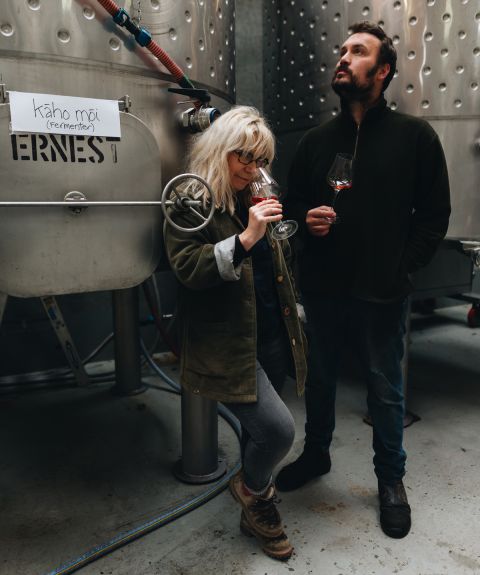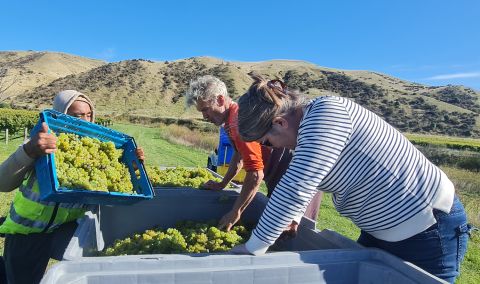Unless one travels the length of New Zealand and stays a good while in each of the ten geographical indications (see this map), it’s difficult to comprehend just how variable the conditions can be from area to area. In some vintages, particularly ones marked by El Niño (see 2019, 2020, 2021), harvest conditions broadly apply to the whole country.
The past two years, however, has seen the country return to La Niña conditions which bring volatile weather with the odd ex-tropical cyclone threat headlining more distinct differences between regions, as well as a generous dose of stress for everyone. The 2023 vintage was perhaps one of the most dramatic examples: it will forever be remembered by those in the north as the ‘Gabrielle’ vintage, and by those in the south as a good-to-exceptional vintage depending on exact location.
Now that the country’s wine industry has had a chance to pause and debrief, it seems the Gabrielle-affected areas are by no means a write-off, though we cannot dismiss the sheer devastation it wreaked on some, taking away both lives and livelihoods in the Hawke’s Bay, Gisborne and Northland areas.
Before Cyclone Gabrielle, there was an earlier storm that brought extensive and severe flooding to the upper North Island including Auckland and Northland, causing at least NZ$1.3 billion of damage. The timing of the Auckland storm was unfortunate, not just because it fell on Auckland Anniversary weekend at the end of January, but for winemakers it was a critical time, just as Gabrielle was for the east coast when it hit over two weeks later (causing NZ$9–14 billion of damage). Wairarapa, tucked inland, missed any major damage from the storms but still suffered a gruelling growing season.
The South Island was very fortunate to miss both events: winemakers (and Jancis herself) at the top of the South Island witnessed the cyclone lashing up the ocean as it tracked out to the east and everyone synchronously thanked their chosen higher power. Central Otago meanwhile carried on in blissful isolation, dealing with a lack of water through summer, ironically, rather than any excess.
North Island details
Northland and Auckland
The weather events through late summer meant significant challenges, with the Auckland Anniversary (27 January) flooding event leaving many properties underwater. Michael Brajkovich MW of Kumeu River expresses that, until then, everything was looking very good for the vintage, but that day they received 260 mm (10 in) rain over a 12-hour period and instances of flash flooding. Luckily there was minimal vineyard damage, and they had water in the cellar for only an hour or so. The problem was the sheer amount of water just four weeks out from harvest.
Downy mildew became a major problem as they were unable to spray the vineyards, and any protection was soon washed off. So when it was time for some Chardonnay vineyards to be harvested, they were effectively defoliated. For Kumeu River, even though Hunting Hill, Coddington and Maté’s all looked amazing on the vine, there were few leaves to continue the ripening process. Having said all that, Brajkovich reports the wines in the cellar are looking very good, albeit a little lighter in texture than the previous four vintages.
Many wineries in Auckland and Northland were fortunate enough to have most of the white varieties in the door by the time the cyclone came knocking, but that doesn’t relieve that it was a challenging growing season due to disease pressure. Yields appear to be about average across the board, but expect lower average alcohol levels, and whites are going to be a better bet than reds – many wineries are likely to not release their flagship red wines this vintage.
Gisborne and Hawke’s Bay
Gisborne and Hawke’s Bay on the east coast of the North Island were also beset by an incredibly challenging growing season: cool conditions through summer with not a day over 30 °C (86 °F) in the Bay coupled with a destructive tropical cyclone meant it was a year for viticultural prowess and meticulousness as well as a healthy dose of luck.
February saw 460.3 mm (18.1 in) of rain fall in Gisborne (655% of its long-term average (LTA) for the month), while Hawke’s Bay received 277 mm (10.9 in) of rain (509% LTA). It appears, however, that the long-term infrastructural damage was felt more in Hawke’s Bay, with buildings, trellising, vines and crop in Esk Valley, Puketapu and Dartmoor seriously damaged by raging floodwaters laden with silt. The impacts here will last for some time. Both regions lost crop completely or partly due to rain-induced disease (both downy mildew and botrytis), with Gabrielle hitting on the 13 and 14 February doing no favours for the grapes, which were between post-veraison and pre-harvest stage.
If you were lucky enough to have vineyards in areas that were not ravaged by flood waters, including the major wine districts of the Gimblett Gravels, Bridge Pa, Mangatahi and Te Awanga in Hawke’s Bay, it was possible to get healthy, ripe fruit harvested if all your viticultural i’s were dotted and t’s crossed because the weather did improve. Geoff Thorpe of Riversun Nursery in Gisborne remarked that on 1 March it was as if someone had ‘flipped the weather switch’.
It was not exactly an Indian summer, but harvest conditions were manageable. Some were as daring as to cross rivers by tractor to harvest grapes due to bridges being washed out. Steve Smith MW of Smith & Sheth warns that the Cabernet family, with its naturally high methoxypyrazine levels, largely struggled to get fully ripe flavour-wise; however, he is confident there will be some small parcels of exceptional Chardonnay and Syrah. The cooler summer moderated alcohols and ensured good natural acidity and elegant aromatic profiles. The Cabernets will need more time in barrel before proper assessment can be made, but early observations are that the best have strong colour.
Martinborough
According to Helen Masters of Ata Rangi, the Wairarapa region had its most difficult vintage on record due to sustained wet weather and cyclone activity. Much like elsewhere in the north, the wet, cool conditions started in autumn 2022 and persisted through winter, spring and summer and have continued into autumn 2023. This has made all vineyard activities such as spraying and under-vine and inter-vine sward management extremely difficult and expensive, requiring more passes through the vineyards with machinery as growth continued throughout the season. Disease pressure has also been extreme. Thinning and re-thinning to reduce crops was the norm, as low temperatures and high soil-moisture levels meant ripening was slow and protracted.
It is a vintage Masters hopes not to repeat, but she reports that the Chardonnays, with amazing acidity and fewer disease issues, are looking exciting in barrel. The late-ripening, hardy Sauvignon Blanc has also fared better than expected. Of Pinot Noir, the Abel clone has come through as the hero: it is later to budburst and ripen, so when cyclone Gabrielle hit the fruit was less advanced and survived to ripen in good condition. The best Pinot Noirs will be elegant and acid-focused.
South Island
Marlborough
Across the Cook Strait to the top of the South Island, Marlborough faced a nervy start to the growing season, conjuring visions of 2022. However, while the total rainfall between January and April was identical to 2022 (192 mm/7.5 in), this year it was more evenly spread. In 2022, 80% of the four-month total fell in February. Most would have said that this growing season felt wet, but in fact total rainfall for the eight-month growing season (September to April) was 95% of LTA (368 mm/14.5 in).
In further contrast to the 2022 season, variable and protracted flowering conditions in December meant early varieties such as Pinot Noir and Chardonnay were below average in yield, while Sauvignon Blanc yields were also only average due to poor fruit set, particularly in the earlier-ripening areas. These resulting loose bunches, however, were critical to the success of the vintage as it meant less disease vulnerability, particularly in Sauvignon Blanc, which is one of the most disease-prone varieties due to its naturally tight bunches. Therefore, while it did rain, there was not the crowding of bunches and subsequent berry split that was suffered more profusely in 2022.
Cold nights were also essential to holding botrytis at bay and maintaining acidity. Some wineries pushed the button on harvest early, presumably with thoughts of 2022 in their mind, but as the weather really played an exceptional hand through March and April, those who held steady were rewarded with excellent Brix levels, intense flavours and good acidities across all varieties.
Now the whole district is buzzing about this vintage, with winemakers surmising about where it slots into their top five ranked vintages of all time. It’s an excellent vintage across the board for Marlborough, with naturally lower yields for Pinot Noir and Chardonnay and average to just below average yields for Sauvignon Blanc.
This leads to the question: everyone loves the El Niño drought years because it’s so easy from a disease-pressure perspective, but looking at this vintage, arguably akin to a Marlborough vintage of the early 2000s, is Sauvignon Blanc best in those years? Assessing the nascent wines in the winery, one could conjecture that Sauvignon’s optimal potential is realised in these benign La Niña conditions.
Nelson/Tasman
A quick phone call with James Healy of Abel Wines in Tasman (Healy points out that all vineyards in Nelson are actually located in the Tasman district) confirmed that Marlborough’s top-of-the-south counterpart shared a similar narrative to Marlborough’s harvest. It was a shaky lead-up and invariably the weather dictated many picking decisions. The Healys picked their fruit in the Upper Moutere at slightly lower sugar levels than normal as a result, but a scrupulous harvest crew can be evidenced in the quality of the wine at this early stage. In essence, while they would have liked slightly more yield, they are very happy with what they have.
North Canterbury
North Cantabrians are also pretty happy with harvest, experiencing slightly more rain than usual during the growing season (133% of LTA July – February 2023), which increased disease pressure and meant precise viticultural management was critical. However, in the subregion of Waikari, where notable producers Pyramid Valley and Bell Hill are located, a devastating October frost reduced harvest volumes significantly. Early indications are that the Pinot Noirs will be fresh and elegant.
Central Otago
Central Otago’s growing season can be described as nothing short of a dream lead-in, if not a bit dry, with drought stress in some areas due to lack of rain (just 44.4 mm/1.7 in of rain fell from December through until mid February). Flowering was a little unsettled but overall it was a very good, even fruit set.
The region was then abruptly reminded what rain was just before harvest, receiving 40 mm (1.6 in) in a couple of days. However, for most it was relatively easy to pick around the forecasted rains as the fruit was in such clean, healthy condition. At the end of March, a very cold period with several frost events, one of which was reasonably serious (-5 °C/23 °F in some places), resulted in a slowdown of most canopies as they started to yellow. Unharvested vineyards slowed down ripening immensely, and the regional harvest window stretched well into late April.
It is likely the best wines will come from the earlier areas such as Bendigo and lower-cropping parts of Bannockburn, though Grant Taylor of Valli Wines has his bets on Gibbston, which ended up having the longest hang-time and, being cooler, always manages to retain higher natural acidity and freshness.

















